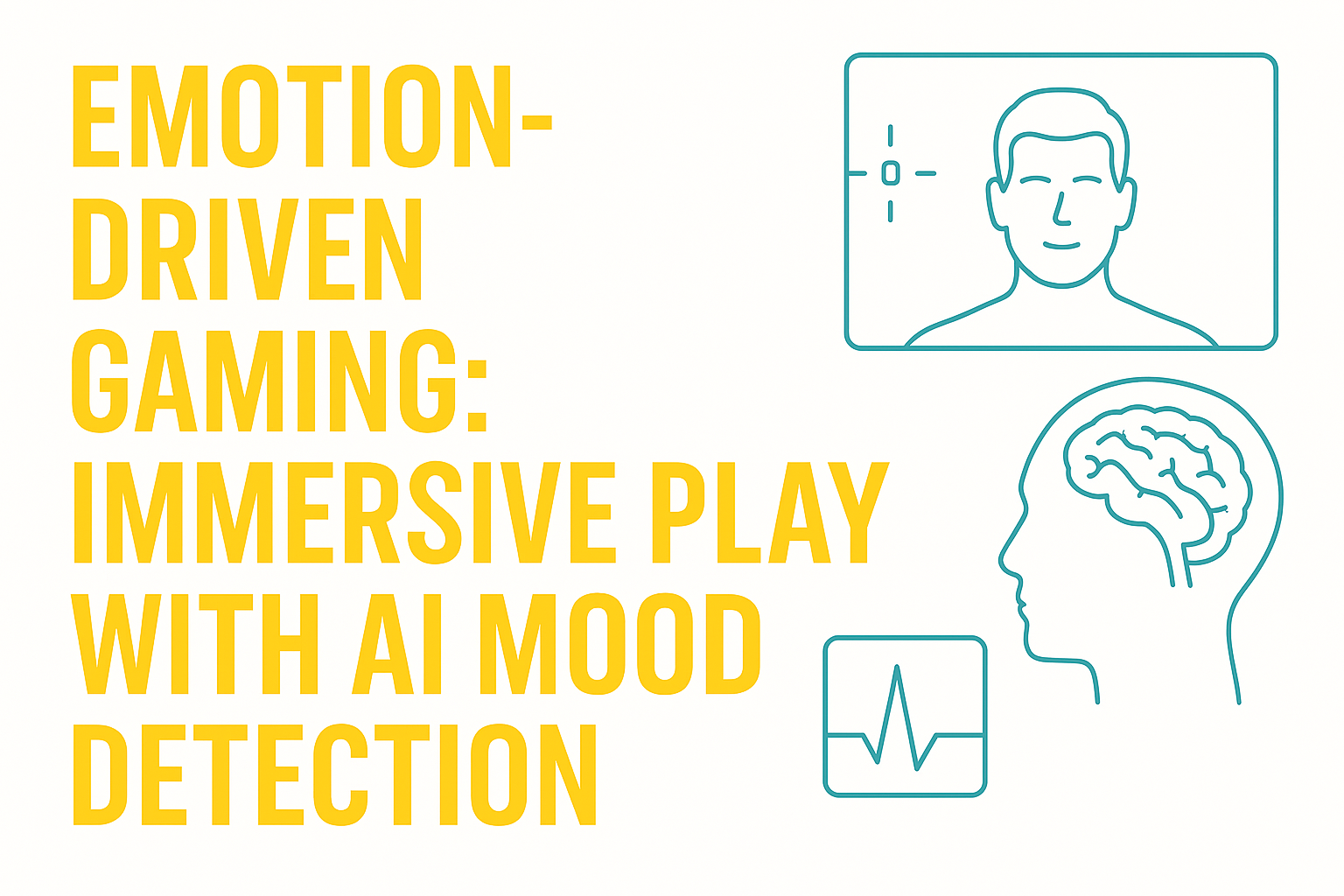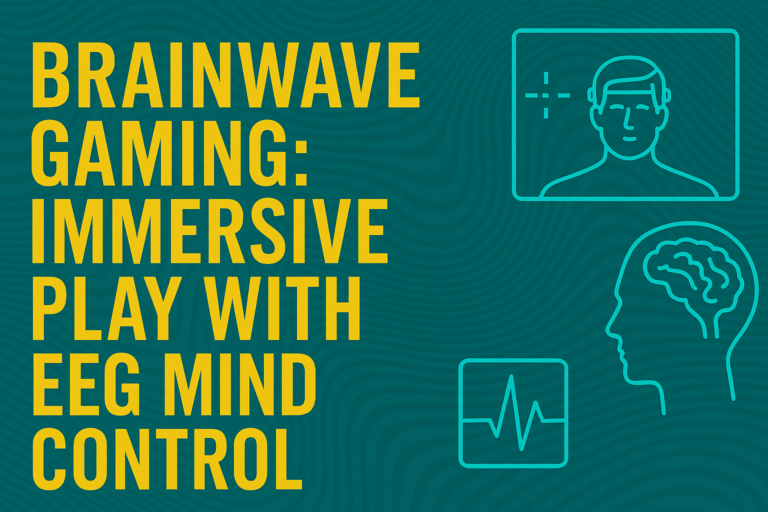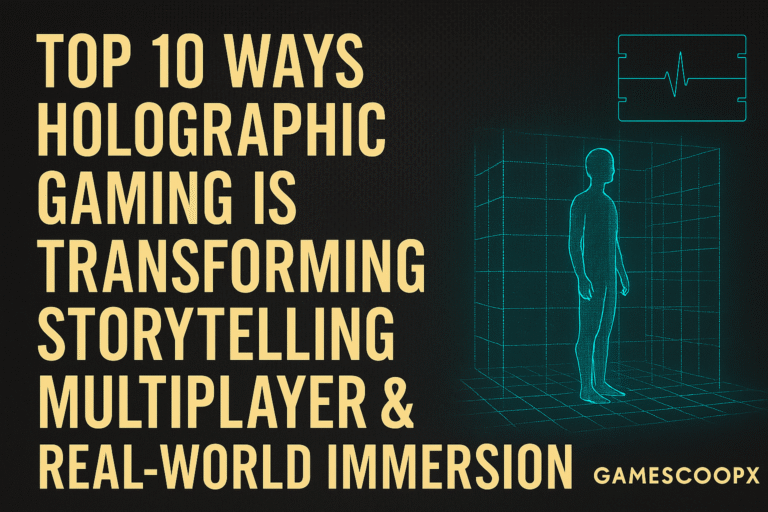
Explore how AI detects player emotions in real time—see it visualized in this clean, white-background thumbnail featuring neural HUD overlays and immersive gameplay cues.”
Emotion-Driven Gaming Thumbnail
Table of Contents
- What Is Emotion-Driven Gaming?
- How AI Reads Your Mood
- Adaptive Storytelling & Dynamic Plot
- Real-Time Difficulty Shifts
- Emotion-Responsive NPCs & AI
- Biometric & Facial Recognition Tech
- Ethical & Privacy Considerations
- Top Tools & Platforms
- Internal & External Link Strategy
- Conclusion – The Future of Emotion-Driven Gaming
1. What Is Emotion-Driven Gaming?
Emotion-driven gaming puts AI mood detection at the heart of interactive entertainment. By capturing facial expressions, voice cues, and biometric signals, titles evolve in real time—delivering tailor-made challenges, branching narratives, and dynamic difficulty that pulse in sync with the player’s emotional state. This isn’t simply adaptive difficulty; it’s a living world that breathes with you.
2. How AI Reads Your Mood
AI mood detection taps multiple inputs to infer your emotional state:
- Facial Expression Analysis: Computer vision models detect micro-expressions—raised eyebrows, tense lips—to gauge stress, surprise, or joy.
- Voice Tone & Prosody: Variations in pitch and volume signal frustration, excitement, or calm.
- Biometric Sensors: EEG headsets and heart-rate monitors feed real-time physiological metrics into machine learning classifiers.
These streams combine to map emotions like anger, boredom, and curiosity—enabling games to adjust on the fly.
3. Adaptive Storytelling & Dynamic Plot
Emotion-driven gaming reshapes narrative design in three key ways:
- Branching Dialogues: NPCs respond empathetically if you appear anxious, offering reassurance or alternate quest paths.
- Live Plot Manipulation: Critical story beats pivot based on emotional peaks—your thrill unlocks secret chapters, while boredom reroutes you toward action segments.
- Personalized Character Arcs: Allies recall past emotional highs and lows, altering loyalty and influence on endgame outcomes.
Deep dive: Analytics Insight’s piece on Emotional AI in Gaming explores real-world implementations.
4. Real-Time Difficulty Shifts
Maintaining “flow” is crucial. Emotion-driven games use mood data to modulate challenge:
- Dynamic AI Opponents: Boss health, reaction speed, and attack patterns adapt to stress levels.
- Environmental Tweaks: Puzzle intricacy, enemy spawn rates, or resource scarcity shift as focus waxes and wanes.
- Well-Being Prompts: Recognizing frustration, the game can suggest a break or offer in-game hints.
See how Quantum Computing Solutions analyzes these mechanics in AI-driven dynamic stories.
5. Emotion-Responsive NPCs & AI
Emotion-driven AI empowers NPCs with:
- Emotive Memory: They recall emotional contexts—if you betrayed them in frustration, they’ll hesitate to help later.
- Mood-Matched Behaviors: Light banter when you’re calm, stern warnings when you’re tense.
- Collaborative Strategies: In co-op modes, allies offer support when they detect stress spikes.
Internal reference: Discover how mind-controlled input set the stage in our Neural Gaming Interfaces post.
6. Biometric & Facial Recognition Tech
Key tools powering emotion-driven gaming:
- EEG Headsets (OpenBCI, NeuroSky): Map brainwave patterns to gameplay events.
- Heart-rate sensors (Ovomind DK1) translate your pulse into measurable emotional responses.
- AI Vision SDKs (Microsoft Azure Face API): Detect and classify real-time facial emotions.
Developers can integrate these via Unity or Unreal plugins to supercharge immersion.
7. Ethical & Privacy Considerations
Emotional data is deeply personal, making it essential to follow strict best practices:
- Data Ownership: Players retain full control over their emotional profiles.
- Informed Consent: Clear opt-in protocols before biometric tracking begins.
- Anonymized Analytics: Aggregate mood data for balancing, not targeted manipulation.
Industry standard frameworks—like Ovomind’s certification guidelines—ensure ethical deployment.
8. Top Tools & Platforms
- Ovomind DK1 Smartband – Biometric software tools paired with heat map analytics
- Microsoft Azure Face API – Real-time emotion detection
- Unity Emotion Plugin – Facial and voice-driven inputs
- Promethean AI – Predictive story branching
- OpenBCI Galea – EEG and EMG headsets designed for real-time neural feedback
9. Internal & External Link Strategy
Internal Links:
- Neural Gaming Interfaces
- Sensory Gaming: Haptics & Smells
External DoFollow Links:
- Analytics Insight’s Emotional AI in Gaming
- Quantum Computing Solutions’ AI in Dynamic Game Stories
- Ovomind’s Emotion-Driven Gaming DK1 Tech
10. Conclusion – The Future of Emotion-Driven Gaming
Emotion-driven gaming is a new paradigm, where your feelings become core gameplay variables. As AI mood detection and biometric sensors mature, anticipate worlds that breathe, adapt, and resonate with your emotional journey.
“The ultimate immersive frontier isn’t what you see or hear—it’s what you feel.”


